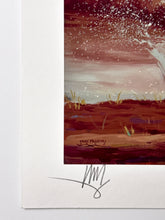
Dimensions: 22 x 26 Inches
Medium: Archival pigment print on 300 GSM cotton rag fine art matte paper.
Provenance: Hand-signed, embossed, and numbered by the artist. Comes with gallery Certificate of Authenticity.
Edition: Limited Edition of 151 (#66/151)
Year: 2023
Condition: Excellent
ABOUT THE ARTWORK
"Some called it the American Desert. Others, the Great Plains. But those phrases were invented by professors at universities Surrounded by the illusion of order. And the fantasy of right and wrong. To know it, you must walk. Bleed until it's dark. Drown in its rivers. Then its name becomes clear. Like God had decided to light this day with candles, the whole of Texas spread out before me. It was the most magnificent thing I had ever seen. Untouched by our dirty hands. To see it is to be silenced by it. Made speechless by its endless uniformity... One must read the sun and stars like a sailor to navigate this place. We've seen nothing but grass for over a week. No grass, no birds. No snakes. Not even a lizard. And no evidence the human race still exists. But the plains are littered with bones. The dirty hand of man can go unnoticed in a city. because his dirty hand made the city. But in this place, where innocence is a mineral in the soil, the filth of our touch is an apocalypse. We have come too far to turn around." -Elsa Dutton, 1883.
ARTIST BIO
Mark Maggiori’s first views of America were framed within the front windshield of a car making its way from New York to San Francisco. That month-long trip, filled with majestic views of the national parks and timeless glimpses of the West, was made when Mark was only 15 years old and on vacation far from his home in France, but its impact would ripple throughout his life and set into motion his great fascination with the West.
Years later, back in Paris, he would enroll at the famous Academie Jullian, where Western greats Ernest L. Blumenschein, Burt Geer Phillips and Joseph Henry Sharp had also studied before they helped form the Taos Society of Artists.
After being formally trained in academic drawing, Mark’s life would take an important detour through music after he formed a successful band that led to many opportunities in Europe, including into other artistic disciplines such as animation, photography and filmmaking—each one informing his artistic creativity in unique ways.
After great success in the music industry, Mark was lured back to the United States thanks to his muse, creative equal and wife Petecia Lefawnhawk. They journeyed through the West and their trips immediately took him back to that original road trip two decades earlier, the trip that opened his eyes to the beauty of American West. It was then, at the age of 36, he made the decision to paint Western art. They staked temporary claims in out-of-the-way places such as Chloride and Kingman, Arizona, where the desert offered its stunning inspiration and where Mark quickly began to produce some of the most audacious Western paintings of a new generation—audacious because Mark was still brand new to the Western art world, and also because he was an outsider, a Frenchman, with a profoundly unique view of the American cowboy. In the space of just a few short years Mark rose through the ranks to become one of the premier Western artists working today.
His work brought many new opportunities, including important solo and group shows, and a significant showing at the 2017Night of Artists at the Briscoe Western Art Museum, where he won the Sam Houston award. He also began to expand more artistically: he started to work more in plein air, he spent time on ranches with cowboys and on horseback to acquaint himself more with the Western way of life. He spent time in New Mexico, Arizona and Wyoming and began adding additional figures to his works and new kinds of compositions to his growing arsenal.
Like Henry Farny, another Frenchman who made his way to the Southwest to paint its interesting inhabitants, Mark has carved a unique place for himself within Western art, a place where his work—part Frank Tenney Johnson, part Herbert “Buck” Dunton, with shades of Tom Ryan and Bill Owen—continues to provoke the minds of young and old Western collectors alike.

















